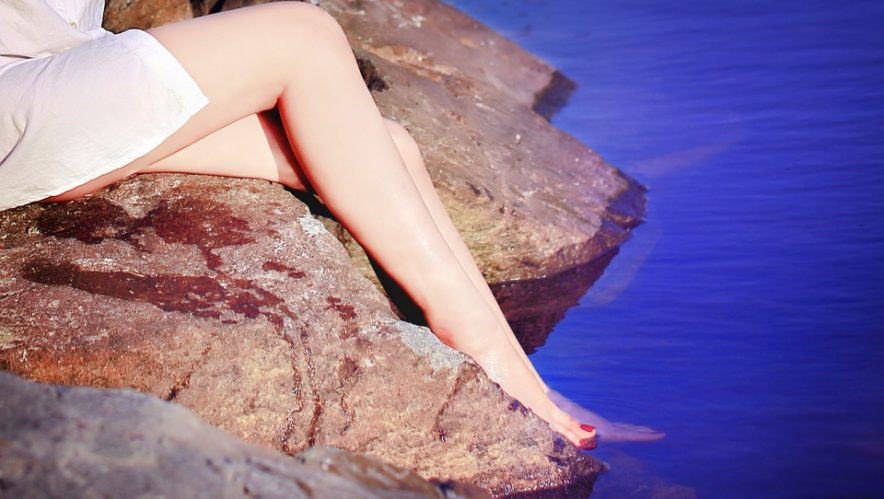No cramp with varicose veins
Development, prevention and treatment
Varicose veins are permanently dilated, irregularly tortuous veins. They occur mainly on the legs, and sometimes in the pelvic area. Varicose veins are the most common of all venous diseases. Every second woman is affected by varicose veins, but only one in four men. Since this form of venous disease is frequently not only an aesthetic problem, but also cause severe afflictions which lead to a reduction in the quality of life of those affected, varicose veins should be treated by a qualified expert.
VARICOSE VEIN PREVENTION
Although the predisposition to varicose veins plays a major role in their development, there are general measures which should be taken to prevent a stronger build-up or deterioration:
Causes of varicose veins
The veins transport the blood from the vessels back to the heart. This process involves a great deal of force in the veins in the legs, as they have to transport the blood against the force of gravity. Breathing as well as foot and leg muscles are used as natural pumps. The muscles compress the veins during movement so that the blood reaches the heart. Each vein also has dozens of venules which prevent the blood from flowing back into the vein. The venal lobes are thus used as valves. When these valves no longer function properly, the blood partially flows back again, and ultimately leads to excess pressure in the leg vein system.
The development of varicose veins is promoted by hereditary predisposition to venous weakness.
In addition, lack of exercise as well as being overweight can be the cause of varicose veins. Pregnancy can also facilitate the development, because of the hormonal changes and weight gain.
Oestrogen is often associated with venous pain. Therefore, caution should be exercised when taking hormone preparations (the pill). Sitting and standing activities are also unfavourable.
DIFFERENT KINDS OF VARICOSE VEINS:
The smallest extended skin veins are spider veins, which glimmer blue or violet through the skin. These spider veins are not a disease in the medical sense, but for many people they are a significant cosmetic problem. Sclerotherapy treatment or laser therapy can improve the complexion,
Reticular varicose veins are somewhat more enlarged. In the actual varicose vein disease, the superficial veins are affected, which is called the strain varicose vein.
The most frequent form is the greater saphenous vein, which is caused by congenital venal wall weakness. Greater saphenous veins emerge, for example, through venous stasis or because of no longer functioning venous valves.
A secondary varicosis is referred to when there is clogging – known as thrombosis – of the deep vein. The thrombosis then causes a strong increase of pressure, making the blood flow against the current over the connecting veins and a backlog builds up into the superficial vein system. This results in the well-known image of the dilated varicose vein.
Diagnosis of varicose veins
Firstly, a physical diagnosis is carried out for the diagnosis of varicose veins. As varicose veins usually occur on the legs, especially the lower legs, the expert will then look at the legs and scan them for abnormalities.
Instrumental diagnostic
The most important instrumental diagnostic is the ultrasound examination with colour-ultrasound (colour coded duplex sonography). Resulting from this, superficial and deep veins, and especially the venous lobes, can be accurately assessed.
Diagnosis of varicose veins
Although varicose veins will always remain sick vessels, aggravation of the veins can be countered with the right therapy and an abatement can be induced. Untreated varicose veins can lead to complications such as severe swelling in the leg, venous inflammation and open wounds (“open leg”).
Conservative Measures
As an accompanying measure to alleviate symptoms, specialists in all types of varicose veins recommend physical measures such as Kneipp treatments, cold lower leg affusions, or treading water. These make the dilated veins contract. A lot of walking, also barefoot, as well as vein gymnastics support the muscle pump function, allowing the blood to be transported back.
Vein remedies can have a slight decongestant effect and subjectively alleviate the symptoms. Vein remedies can’t and shouldn’t replace necessary compression therapy. Their administration may be useful for a limited period of time if compression therapy is not possible – for example, if you suffer from allergies or during very hot periods – and if a subjectively favourable effect is desired.
So-called endovenous therapy methods
Various new therapeutic measure are available. Which method is the most appropriate in each individual’s case is decided by the examination results which are collected beforehand, in accordance with the wishes of the patient. The advantages and disadvantages of the treatment are weighed against each other.
By injecting a sclerosing agent in the vein an artificial venous inflammation is created so that the venous walls glue together from the inside. They then heal over time. For the treatment of small veins (spider veins, reticular varices) the debilitating agent is injected as a liquid, and in the case of larger veins (greater saphenous veins, side branches) as foam.



